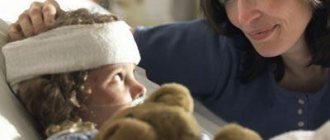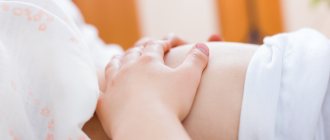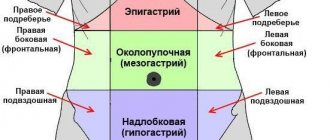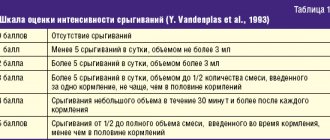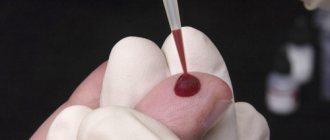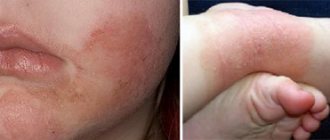Any poisoning is always unpleasant, especially when it comes to children. At the first symptoms of poisoning, many parents begin to fuss and worry. But worrying won’t help here; the child needs to quickly receive specific medical assistance and then show it to a doctor. Do not panic if your child starts vomiting. This is a completely normal phenomenon, as the body tries to get rid of toxic substances that have entered it. If vomiting becomes indomitable, then you need to use antiemetic drugs for children that can stop the unpleasant urge.
Causes of vomiting in a child.
Nausea and vomiting in a child are the most unpleasant signs that signal the emergence of problems in a fragile body. What the symptoms indicate and what medications for this are used for children of different ages in each specific case will be described in detail below. The child's body is characterized by increased susceptibility to any changes in the processes occurring inside.
Parents should be especially wary of vomiting in children under one year of age, since there is a risk of vomit getting into the respiratory tract.
However, vomiting should be distinguished from regurgitation, which is considered normal for infants. In older children, the most common causes of nausea and subsequent vomiting are:
- food poisoning;
- indigestion;
- binge eating;
- inflammation of the gastrointestinal tract;
- intestinal obstruction
- neurotic conditions;
- acetonemia;
- motion sickness;
- foreign object.
To get rid of vomiting and nausea, medicines for children are selected depending on the nature of the disease.
When should you start taking antiemetic drugs?
If the child’s vomiting does not stop for a long time, then they begin to give antiemetics for children. This can only be done after consultation with a pediatrician or infectious disease specialist. If the nearest medical facility is far away, you can call an ambulance, where a doctor can advise on the advisability of taking such drugs.
If you suspect rotavirus, you should not immediately try to stop vomiting. This is how the body fights pathogenic microorganisms that have penetrated it. If you immediately take anti-vomiting pills for children, the stomach will not have time to clear itself naturally, which means that the disease may not only drag on, but also cause serious complications.
Types of anti-vomiting remedies
A single vomiting is not dangerous for a child’s body, but repeated manifestations threaten children with dehydration, especially when it comes to the age of under 1 year. Therefore, finding out the reasons and influencing them is the main task of the specialist and parents.
If the cause is an intestinal infection, they give antiviral drugs, poisoning - sorbents, if meningitis or traumatic brain injury - the baby is urgently sent to the hospital.
You should pay attention to the accompanying symptoms in order to give your doctor complete information!
Drugs that stop vomiting can be used for any etiology of this phenomenon, because they will serve as the main symptomatic remedy, and many as a therapeutic one. For the treatment of conditions accompanied by vomiting, the following drugs are prescribed in complex therapy:
| Group | Example of a pharmaceutical product | Price, rubles |
| Antiemetics with central action | Metoclopromide | 35 |
| Dopamine receptor blockers | Domperidone | 140 |
| Histamine receptor blockers | Dramamine | 220 |
| Homeopathic medicines | Air-sea | 220 |
| Sorbents | Enterosgel | 450 |
If the baby frequently vomits, streaks of blood appear, the temperature continues to rise, sharp pains and other alarming symptoms are observed, you cannot wait. You need to call an ambulance and not experiment with taking pills!
special instructions
In case of severe dehydration, when the fluid deficiency is 10%, intravenous rehydration medications are first used, after which Regidron is allowed to be used.
It is highly not recommended to increase the therapeutic dose on your own. Because this can lead to hypernatremia. This condition is harmful to the body.
The solution should be drunk immediately after dilution. It is not permissible to add flavor enhancers - sugar or honey. You should also eat food after taking Regidron.
If vomiting occurs, patients are given the solution to drink only 10 minutes after the attack. It is important to drink liquid in small portions.
If the level of fluid in the body decreases due to diabetes mellitus or liver failure, the medicine should be used under the strict supervision of a doctor.
Medicines for vomiting and diarrhea
Most often, the cause of symptoms is rotavirus infection, food poisoning, enterovirus infection, or other intestinal pathologies. Less often, the prerequisite is a more serious intestinal disease - salmonellosis, dysentery. To relieve vomiting and diarrhea, give the drug Smecta in the following daily dosage, divided into 3 parts:
- up to one year - 1 pack;
- 1-2 years - 2 packs;
- 2-3 years - 2.5 packs;
- from 3 years - 3 packs..
Before use, the pharmaceutical preparation should be dissolved in water (50-70 ml), preferably taken before meals. The course of therapy is 7 days. Smecta binds toxins in the gastrointestinal tract, improves the protective properties of the mucous membrane, and helps remove viruses and bacteria. You can replace Smecta with any enterosorbent - Activated carbon, White carbon, Enterosgel, Polysorb.
There is another effective medicine for any gastrointestinal disorders - Enterofuril (350 rubles). It contains nifuroxazide, a strong intestinal antiseptic that does not upset the balance of natural microflora. Enterofuril destroys and removes any infection, is active against all known pathogens, only in case of severe infections it will not be enough to cure. Children under 2 years of age are given the drug in the form of a suspension, half or a whole measuring spoon three times a day. For older children, the dosages are as follows:
- children 2-4 years old - 100 mg four times a day;
- children 5-7 years old - 200 mg three times a day;
- from 7 years - 200 mg four times a day.
The drug is contraindicated only for infants up to a month old and premature newborns; allergic reactions are only occasionally observed as side effects.
Rules for processing and preparing products
Preparing food for children with consequences of vomiting requires special care. Products must be fresh, all dishes are prepared in such a way that they can be eaten immediately. All products are thoroughly washed under running water, cut and cleaned on various cutting boards. Food is served warm; you should not offer your child food from the refrigerator or very hot food.
Dishes are prepared only by steaming or boiling in weak meat broth and water. If vomiting was caused by problems with the gastric mucosa, the products should be crushed with a blender or rubbed through a sieve. The cereal is very overcooked, and for infants, boiled cereal is ground into jelly.
Drugs based on domperidone
The active substance domperidone is included in many anti-vomiting medications. Which one to choose depends on age and dosage form. Here are the main tools:
- Domperidone, tablets (140 rubles) - from 6 years;
- Motilium, suspension (650 rubles) - from a month;
- Motilium-express, lozenges (630 rubles) - from 5 years;
- Passazhix, chewable tablets (300 rubles) - from 5 years;
- Motilak, tablets (320 rubles) - from 5 years;
- Motonium, tablets (230 rubles) - from 5 years.
Domperidone is indicated for digestive disorders, which are accompanied by nausea, vomiting, as well as additional symptoms - heartburn, belching, hiccups, pain. In infants, Motilium suspension is used for severe regurgitation, and the medicine must be given at night.
Domperidone improves the tone of the sphincters of the stomach and esophagus and the function of the gastrointestinal tract in general.
Generally, single-dose domperidone preparations can be used in most children. But for course treatment (for example, for gastroesophageal reflux, which is accompanied by nausea), there are a number of contraindications. These include pituitary tumors, intestinal obstruction, renal and liver failure, and perforation of the gastrointestinal tract. Tablets can cause thirst that is difficult to quench, constipation, and migraines.
Restoring water balance
In case of poisoning, the child suffers from severe vomiting and diarrhea, due to which a lot of fluid leaves the body and dehydration begins.
In between gagging, the child should be fed small portions, this will slightly restore the water balance. Pure still water, decoctions of raisins and dried apricots, as well as water with the addition of lemon juice and honey are suitable for drinking. You can use the pharmaceutical drug rehydron, but it has an unpleasant taste, so children take it with great reluctance.
Milk and dairy products, soda, coffee and strong tea should not be used for feeding children.
Vomiting in transport - treatment
Children very often experience so-called motion sickness in transport - in a car, on an airplane. There are a number of effective medications available to combat the condition. For example, a good anti-vomiting medicine for children is Aviamarin with dimenhydrate (200 rubles/10 tablets). The drug belongs to histamine receptor blockers; it eliminates spasms of the stomach and intestines caused by histamine. The drug gives an antiemetic effect and at the same time gives a sedative effect. Children over 6 years old are given half or a whole tablet every 6-8 hours, as needed.
Another good medicine is Avia-Sea which is homeopathic. The procedure for taking it from the age of six is as follows:
- one tablet per dose;
- it must be dissolved in the mouth, slowly dissolving;
- do not use with food;
- The first dose should be taken an hour before the ride, then repeated every half hour (up to 5 tablets/day).
Avia-sea contains a whole set of homeopathic components diluted with C200, which effectively reduces the body’s autonomic reactions, eliminates nausea and other symptoms of motion sickness.
For babies from birth, you can use the safe anti-sickness plaster Extraplast.
The patch contains only herbal ingredients - ginger, mint, dope, these substances quickly eliminate nausea and dizziness in transport, and are their prevention. One pair of plasters should be glued behind the ears and replaced with new ones after 3 hours.
How can you help your child at home?
The most important thing in treating vomiting is to feed the child. Children are more susceptible to conditions of dehydration and toxicosis than adults, so it is extremely important that the volume of fluid lost through vomiting is replenished.
Main groups of drugs
Vomiting is a protective reaction of the digestive system to the ingestion of toxic substances, infectious agents and their toxins. Therefore, it is very important to be careful when using antiemetic drugs, as they can harm the child.
What drugs are used for vomiting in children? Enterosorbents, antiemetics, and oral saline solutions are used for intestinal infections. In other cases, treatment will vary depending on the cause of vomiting, but they are all united by the need to replace fluid lost through vomiting by either oral administration or infusion therapy.
The use of antiemetic drugs (Motillium, Motillac, Ondansetron) is indicated only in case of persistent vomiting and should only be done on the recommendation of a doctor.
Among enterosorbents , the use of drugs such as activated carbon, Smecta, Dimosmectit, Polysorb, Enterosgel and others in age-related dosages is indicated.
Probiotics have not shown significant benefits in their use in studies, especially in the acute period. Among all the drugs in this group, only those containing Saccharomyces boulardii and Lactobacillus rhamnosus GG have proven their effectiveness.
Preventing dehydration
Prevention of dehydration and first aid for vomiting in a child consists of adequate feeding.
Feeding a child requires perseverance and patience from parents!
It is important to remember that you should not give your child any liquid for 40 minutes - 1 hour, so as not to provoke another episode of vomiting!
You should not allow your child to go hungry. That is, it is necessary to feed the child.
It is best to feed small children using a syringe (without a needle), a bottle with a pacifier or a teaspoon.
Soldering must be fractional. That is, it is best to give 1 teaspoon of liquid every 3-5 minutes.
Symptomatic treatment for vomiting in children
Symptomatic therapy for vomiting in children consists of oral rehydration and taking enterosorbents. This is the basic first aid for a child who is vomiting. For oral rehydration, drugs such as Normohydron, Gastrolit, Oralit, Regidron, Humana Electrolyte, Orsol and others are used.
The volume of solution required for drinking depends on the weight of the child and his pathological losses through vomiting. At the initial stage, the child should receive approximately 50 ml/kg of solution in 8 hours. Then, if necessary, the volume expands.
First aid for a child
It is important for adults who do not have medical training to understand that they cannot, do not know how, and should not make a diagnosis, assess the severity of the condition, or treat a child who is vomiting. Their task is to prevent complications and alleviate the condition, nothing more. And to solve it there are several successive stages.
Avoid scheduled and unscheduled feedings. No matter how obvious this point may seem, it still needs to be mentioned. If a baby is vomiting, he should not be fed, and it is especially important to tell grandparents this. It is they who often think that nausea provokes hunger, and by hook or by crook they try to convince the baby to eat at least a little.
On the other hand, the sufferer himself can try to benefit from his condition by asking for candy or cake.
The answer is to master your parental instincts and gently but firmly explain that putting any food into the stomach of a person who is vomiting can trigger another attack.
The younger the child is in age and weight, and the more strongly he vomits, the faster exicosis occurs (that is, dehydration) - a condition dangerous to the health and even the life of the baby. To prevent it, it is necessary to ensure that the body receives clean drinking water and salts, which are inevitably lost during vomiting.
Drink actively, abundantly, and even against desire.
The most preferred group of products are powdered pharmaceutical products for oral rehydration with sodium, potassium and other substances in specially selected proportions: Rigidron, Humana Electrolyte, Glucosolan, etc. These medications are recommended to be taken without a doctor’s prescription for poisoning, heat and sunstroke, allergies, fever , so it is highly advisable that they are always in the first aid kit
Instructions for use of Regidron for children
For children and adults, Regidron is prescribed orally. Dilute the powder in water, previously boiled (35-40°C).
After preparation, the medicine can be stored in the refrigerator for no more than a day.
The therapeutic dosage and course duration are determined by the doctor, taking into account the child’s well-being, diagnosis and body weight.
To relieve symptoms of diarrhea, it is recommended to drink the solution for 3-4 days. Give 30-60 ml/kg to older patients. Newborns are recommended to take 5-10 ml every 10 minutes in the first 4 hours of the onset of diarrhea.
When vomiting, Regidron is taken chilled.
During the treatment period, it is important to pay attention to the nature of your diet. It is advised to exclude excess food and liquid. If you feel very hungry, it is better to give your child easily digestible food with less fat.
Smecta for kids
Smecta is one of the most common remedies for intestinal infections. The effect of the drugs is similar to activated carbon, but is stronger and more effective. Smecta is available in powder form and can be given even to small children up to one year old. You need to take the medicinal powder at the first signs of nausea; the course of treatment is one week. Analogues of Smecta are Neosmectini Polyphepan.
Brief description: the drug is of natural origin and has an absorbent effect. Due to dioctahedral smectite, glucose, saccharin and vanillin, which are the main active components, the mucous barrier is stabilized and the gastroprotective property of mucus is improved. In small doses, the powder does not disrupt intestinal motility.
Smecta and drugs of similar action are indicated for acute, chronic and infectious diarrhea, heartburn, bloating, and diseases of the gastrointestinal tract.
Directions for use: the contents of the sachet should be dissolved in half a glass of warm water. Children under two years old take one sachet per day, children over two years old - 2-3 sachets. For infants, the contents of the sachet can be dissolved in milk or mixed with semi-liquid products in the form of porridge or baby food. Side effects: constipation occurs very rarely after taking Smecta. In this case, you can reduce the dosage, but you should not stop treatment.
Methods for examining the digestive tract
Vomiting and abdominal pain in a child can also be due to worms
If abdominal pain, acute or chronic, or vomiting occurs, the child should be examined. All appointments are made by a pediatrician. As a rule, the local doctor listens to all complaints, collects anamnesis, examines the child, may palpate the abdomen, and then refers to a more specialized specialist - a gastroenterologist.
Tests are required: urine, feces and blood. They will help in making a diagnosis and indicate disruptions in the body and inflammatory processes. A stool test for worm eggs is taken separately. In addition to all of the above, the child may be prescribed the following procedures:
- Gastroscopy. This is a rather unpleasant procedure that involves examining the esophagus, stomach and duodenum using a thin tube that is inserted into the mouth. However, there is currently no more informative examination of the stomach. Using this procedure, you can quickly determine the presence of damage, tumors, bleeding, ulcers, and even immediately eliminate some of them. Children need to be prepared for this procedure, but under no circumstances should they be deceived. It is necessary to provide specific and understandable information, especially to older children. Before gastroscopy, you need to fast for 4-6 hours. If the child is so small that nothing can be explained to him, there is a danger that the child will move and damage the esophageal mucosa, so the procedure is performed under general anesthesia.
- Ultrasound. Ultrasound of the abdominal cavity helps determine the condition of many organs: stomach, liver, gallbladder, etc. However, sometimes the information obtained as a result of this examination is quite general, so further examination is prescribed (for example, FGS). 2-3 days before the ultrasound, it is advisable to keep the child on a non-strict diet: exclude everything creamy, carbonated, unhealthy, fried. It is not advisable for small children to be given vegetable and fruit purees on the day of the examination, since they take a long time to digest.
- X-ray or CT, MRI with contrast. Quite informative and painless examination methods. Unfortunately, it can be difficult for young children to remain motionless for long periods of time in an MRI machine. X-rays are done faster, but some radiation dose must be taken into account. If the intestines are examined, contrast may be injected into the rectum, which is quite unpleasant for the child.
Polysorb for poisoning
Before you start using Polysorb for children, the instructions for use of this medication should be thoroughly studied. It is unacceptable to use the medicine on your own for a long time. If a child has complaints or you think that he needs Polysorb, then you should first contact a specialist. It is often prescribed in combination with other drugs.
The drug is produced in free-flowing powder form. Polysorb is packaged in different volumes.
At the pharmacy you can purchase medicine weighing from 3 to 50 grams. The minimum amount of medication (one sachet) costs approximately 20 rubles. The price of a large can ranges from 300 to 400 rubles. You can purchase the product without a prescription. The drug Polysorb is considered a safe medicine (children can also use it).
Polysorb powder against poisoning for children, as it turns out, is the best remedy. The fact is that the medication begins to work within the first four minutes after administration. Poisoning often occurs due to eating stale food. Its symptoms are known to everyone: nausea, vomiting, diarrhea.
The child may also have a fever due to the effects of toxins. In this situation, it is very important to start treatment as soon as possible. For babies weighing up to ten kilograms, the medication is prescribed half or a whole teaspoon per day. In case of acute allergies and poisoning, the portion can be increased to one and a half teaspoons. Since the daily volume of the drug is divided into 3-4 times, it is necessary to give the baby 0.5 teaspoon of powder.
Symptoms of the pathological condition
Nausea is not a disease. This is a symptom that accompanies diseases or damage to internal organs and systems.
The main sign of nausea is discomfort and unpleasant sensations in the stomach, which children endure painfully. The condition spreads through the upper parts of the digestive system - the esophagus, pharynx. There is a feeling of a lump in the throat, a false urge to vomit without vomiting.
Against the background of nausea, the child experiences a deterioration in general health. Weakness develops, physical activity decreases, and headache appears. The desire to vomit only worsens the condition, since the absence of vomiting does not bring relief.
Nausea in children may be accompanied by additional pathological signs:
- digestive system - vomiting, diarrhea, increased salivation, pain in the epigastric region;
- nervous system - darkening of the eyes, dizziness, drowsiness, rapid breathing and pulse, shallow breathing, feeling of lack of air;
- symptoms of intoxication - weakness, increased sweating (especially in infants), hot flashes, clammy and cold skin, a slight increase in temperature, and in children of the first year of life, weight loss.
How do you understand when a child who cannot yet explain his condition is vomiting? The baby is constantly capricious and refuses to eat. The general condition is restless, periodically there is causeless crying, during which the baby sweats intensely. At the same time, the arms and legs are cold to the touch.
Other antiemetics
Often, for nausea, doctors recommend using Metoclopramide or Cerucal, which have one active ingredient (metoclopramide). In severe cases, these drugs are even given to children by injection - of course, only in a medical facility. They do the following:
- suppress stomach cramps;
- enhance the efficiency of the gastrointestinal muscles;
- improve intestinal motility;
- accelerate gastric emptying.
From 2 years of age, the medicine is given at the rate of 0.1 mg/kg of body weight per dose. A course of treatment is carried out only for persistent nausea and vomiting; in other cases, the drug is taken as needed.
No-spasm with prifinium bromide can also be called a strong anti-nausea and antiemetic. It is produced in tablets, solution, syrup, the latter is most often used in children. The drug is approved from birth - 2 ml every 6 hours. From 6 years of age you can give the drug in tablets. Due to the presence of a large number of contraindications, No-spasm is often replaced with drugs based on metoclopramide or domperidone.
Parental tactics for dealing with certain types of nausea
Treatment directly depends on the cause of nausea. The first action is to eliminate the provoking factor:
- refusal to eat;
- drug withdrawal;
- removing warm clothes;
- stopping exposure to the sun;
- stopping and exiting the vehicle for fresh air.
Binge eating
Nausea occurs due to insufficient breakdown of food into proteins, fats and carbohydrates. Therefore, the child needs to be given enzymes. These drugs are of natural origin, safe for the health of children, and do not have serious side effects. They improve the processes of digestion and absorption of nutrients.
The drugs are available in tablets and capsules. The tablets are coated with a special coating that does not dissolve in the stomach. This is necessary for the enzymes to enter the duodenum. Only in this case will they be effective. Therefore, you should not bite or crush the tablets.
Pancreatic preparations:
- Pancreatin.
- Mezim.
- Festal.
- Pancreol.
- Enzistal.
Children who cannot swallow a pill on their own are given the drug Creon. It is available in capsules, the contents of which are small granules coated with a coating insoluble in gastric juice. The drug can be given with milk, formula and any other food.
You can give your child antacids for nausea without vomiting. They gently envelop the walls of the stomach, relieve irritation of the mucous membrane, and reduce acidity. Antacids relieve symptoms such as heartburn, a feeling of bitterness in the mouth, and abdominal discomfort. Most drugs are available in the form of a suspension or powder for its preparation, less often in tablets.
List of drugs:
- Almagel.
- Phosphalugel.
- Maalox.
- Gaviscon.
- Gastracid.
- Rennie.
Folk remedies help to quickly cope with nausea. Babies in the first year of life are given dill water. You can prepare it yourself, but you must strictly adhere to the recipe. It is better to purchase ready-made granules in a bag at the pharmacy, dissolve them according to the instructions and give them to the child throughout the day. It relieves nausea, cramps, is a mild laxative and diuretic.
Preparations:
- Plantex.
- Dill water.
- Dill.
- Children's instant teas based on fennel - “Hipp”, “Baby”, “Bebivita”, “Humana”.
School-age children, if they feel nauseous, can be offered green tea with a slice of lemon. Decoctions of lemon balm or mint and tincture of orange peels will also relieve the unpleasant symptom.
Poisoning or acute intestinal infection
In this case, you can give the child some remedy for nausea, but it will be ineffective, since the infection is always accompanied by vomiting. Moreover, taking the drug can speed up its appearance.
Against the background of intoxication of the body, children rapidly develop dehydration. Loss of fluid is dangerous for a small organism. Therefore, at the first aid stage, the key action is to provide the child with plenty of fluids. You need to drink warm liquid, often and in small sips, so that it has time to be absorbed in the stomach. You should not drink in one gulp or in large quantities, this will provoke additional vomiting and increase dehydration.
As a liquid, the child can be offered any still water (purified, mineral), compote, juice or fruit drink diluted with water, or non-hot tea. Abundant intake of moisture into the body will reduce intoxication and reduce symptoms of nausea and headaches.
Head injuries and brain diseases
In case of traumatic brain injury, it is contraindicated to give the child any traditional anti-nausea medications. The mechanism of development of this symptom is not related to the activity of the gastrointestinal tract, and therefore all drugs will be ineffective.
If serious brain damage has occurred, and nausea and vomiting are constantly present in the child, the following medications are prescribed:
- Diazepam.
- Domperidone.
- Lorazepam
- Aminazine.
The listed drugs are potent narcotic neuroleptics with many side effects. They are prescribed only by the attending physician. These drugs are not available for free sale in pharmacies. They are available by prescription only.
Assisting a child with motion sickness in transport
If a child gets sick in the car, you need to stop immediately, open the window, and in the warm season it is better to go outside. Unbutton outerwear, top buttons on a shirt or jacket, loosen the collar. Provide maximum access to fresh air.
Offer to drink water. If there is no obvious urge to vomit, you can give your child a lollipop for nausea. Wipe the skin of the face and neck with damp hypoallergenic (non-scented) wipes. The movement can be continued when the nausea subsides and the child’s well-being improves.
Gagging without vomiting in a child is a common phenomenon that parents encounter throughout the entire period of growth and maturation of children. To provide first aid, you need to analyze and correctly assess the baby’s condition. If you suspect the seriousness of the problem, do not self-medicate, but consult a pediatrician or call an ambulance.
How to recover from vomiting?
If unpleasant symptoms are caused by an infection, you need to provide the body with support for a speedy recovery. For this purpose, pancreatic enzymes are prescribed - Pancreatin, Creon. To improve the quality of intestinal microflora, take:
- Linux;
- Bifidumbacterin;
- Primadophilus;
- Hilak Forte.
Bifido and lactobacilli in the preparations will work more effectively if you simultaneously take fermented milk foods and prebiotics - dietary fiber, inulin. Also, we must not forget about consuming large amounts of fluid, and in case of frequent vomiting, Regidron solution. In children, dehydration and loss of salts occur quickly, and serious consequences cannot be allowed to happen!
Contraindications for Regidron
It is prohibited to use the drug in the following cases:
- Various forms of intestinal obstruction.
- Lack of consciousness.
- Severe kidney damage.
- Diarrhea due to cholera infection.
- Individual intolerance to the components included in the drug.
Regidron should be prescribed with caution to patients who have diabetes mellitus of any type.
What to feed a child after poisoning?
Dishes are warm, pureed or served in crushed form - rubbed through a sieve or processed in a blender.
What can you eat after poisoning? Ready-made baby products are perfect for this: meat and fish soufflés, vegetable purees, porridge or home-cooked boiled or steamed dishes. On the contrary, you should exclude: cucumbers, tomatoes, cabbage, wheat, pearl barley porridge.
What can you eat after a period of intoxication? During the recovery period, the menu consists of: boiled chicken meat, buckwheat porridge, natural yogurt, low-fat fish, kefir.
Diet period - 2-3 weeks from the moment of poisoning in children.
Treatment at home with the help of dietary nutrition will help to avoid chronic diseases of the digestive system and other complications.
Now let's talk about what to do while you are waiting for the doctor. So…
